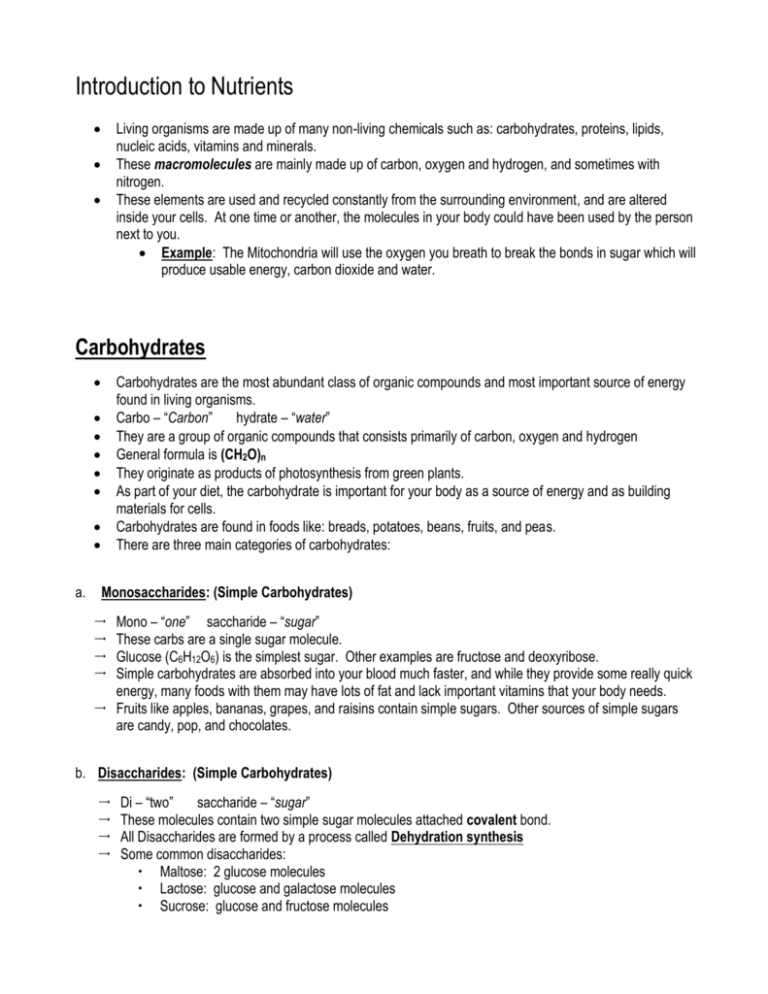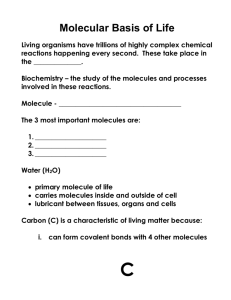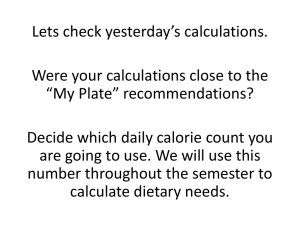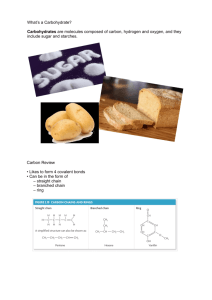Introduction to Nutrients
advertisement

Introduction to Nutrients Living organisms are made up of many non-living chemicals such as: carbohydrates, proteins, lipids, nucleic acids, vitamins and minerals. These macromolecules are mainly made up of carbon, oxygen and hydrogen, and sometimes with nitrogen. These elements are used and recycled constantly from the surrounding environment, and are altered inside your cells. At one time or another, the molecules in your body could have been used by the person next to you. Example: The Mitochondria will use the oxygen you breath to break the bonds in sugar which will produce usable energy, carbon dioxide and water. Carbohydrates Carbohydrates are the most abundant class of organic compounds and most important source of energy found in living organisms. Carbo – “Carbon” hydrate – “water” They are a group of organic compounds that consists primarily of carbon, oxygen and hydrogen General formula is (CH2O)n They originate as products of photosynthesis from green plants. As part of your diet, the carbohydrate is important for your body as a source of energy and as building materials for cells. Carbohydrates are found in foods like: breads, potatoes, beans, fruits, and peas. There are three main categories of carbohydrates: a. Monosaccharides: (Simple Carbohydrates) Mono – “one” saccharide – “sugar” These carbs are a single sugar molecule. Glucose (C6H12O6) is the simplest sugar. Other examples are fructose and deoxyribose. Simple carbohydrates are absorbed into your blood much faster, and while they provide some really quick energy, many foods with them may have lots of fat and lack important vitamins that your body needs. Fruits like apples, bananas, grapes, and raisins contain simple sugars. Other sources of simple sugars are candy, pop, and chocolates. b. Disaccharides: (Simple Carbohydrates) Di – “two” saccharide – “sugar” These molecules contain two simple sugar molecules attached covalent bond. All Disaccharides are formed by a process called Dehydration synthesis Some common disaccharides: Maltose: 2 glucose molecules Lactose: glucose and galactose molecules Sucrose: glucose and fructose molecules c. Polysaccharides: (Complex Carbohydrates) Poly – “many” saccharide – “sugar” These carbs are made up of many sugar molecules linked together into large branching chains. Starch (Amylose) a large carbohydrate molecule used by plants to store energy. Starches can have between 2000-6000 glucose molecules. Starches are found in wheat, potatoes, and rice. Cellulose a component of the plant cell wall made of glucose molecules. Has more of structural role of plant cells rather than energy storage. Cellulose is more commonly known as “FIBRE” Glycogen A large carbohydrate molecule use by animals to store energy All unused, excess sugar transported by the blood are linked together to for a glycogen molecule for later use. When glucose level begin to drop in the blood, glycogen can then breakdown, by way of Hydrolysis, into individual glucose units Complex carbs take longer to be digested, so your body needs more time to release these carbs into your blood as glucose. These are better when you are exercising because they will give you energy that is long lasting. They are also healthier than simple carbs because they usually come with lots of vitamins and minerals your body needs. Commonly found in foods like: bread, noodles, rice, grains, vegetables (corn, potatoes, sweet potatoes, tomatoes, carrots, cucumbers, lettuce, and peppers).








